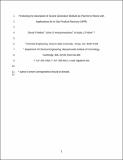| dc.contributor.author | Nielsen, David R. | |
| dc.contributor.author | Amarasiriwardena, Gihan S. | |
| dc.contributor.author | Prather, Kristala L. Jones | |
| dc.date.accessioned | 2012-01-30T16:51:19Z | |
| dc.date.available | 2012-01-30T16:51:19Z | |
| dc.date.issued | 2010-04 | |
| dc.date.submitted | 2009-12 | |
| dc.identifier.issn | 0960-8524 | |
| dc.identifier.uri | http://hdl.handle.net/1721.1/68809 | |
| dc.description.abstract | The application of hydrophobic polymeric resins as solid-phase adsorbent materials for the recovery and purification of prospective second generation biofuel compounds, including ethanol, iso-propanol, n-propanol, iso-butanol, n-butanol, 2-methyl-1-butanol, 3-methyl-1-butanol, and n-pentanol, has been investigated. A simple, yet robust correlation has been proposed to model the relative equilibrium partitioning behavior of a series of branched and n-alcohols as a function of their relative hydrophobicity, and has been applied to ultimately predict their adsorption potential. The proposed model adequately predicts the adsorption behavior of the entire series of alcohols studied, as well as with six different adsorbent phases composed of three different polymer matrices. Those resins with a non-polar monomeric structure and high specific surface area provided the highest overall adsorption of each of the studied compounds. Meanwhile, longer chain alcohols were subject to greater adsorption due to their increasingly hydrophobic nature. Among the tested series of alcohols, five-carbon isomers displayed the greatest potential for economical recovery in future, multiphase bioprocess designs. The present study provides the first demonstration of the ability of hydrophobic polymer resins to serve as effective in situ product recovery (ISPR) devices for the production of second generation biofuels. | en_US |
| dc.description.sponsorship | Massachusetts Institute of Technology. Energy Initiative (Grant Number 6917178) | en_US |
| dc.description.sponsorship | Natural Sciences and Engineering Research Council of Canada | en_US |
| dc.description.sponsorship | Massachusetts Institute of Technology (Class of 1973 Undergraduate Research Opportunities Fund) | en_US |
| dc.language.iso | en_US | |
| dc.publisher | Elsevier B.V. | en_US |
| dc.relation.isversionof | http://dx.doi.org/10.1016/j.biortech.2009.12.003 | en_US |
| dc.rights | Creative Commons Attribution-Noncommercial-Share Alike 3.0 | en_US |
| dc.rights.uri | http://creativecommons.org/licenses/by-nc-sa/3.0/ | en_US |
| dc.source | Prof. Prather via Erja Kajosalo | en_US |
| dc.title | Predicting the adsorption of second generation biofuels by polymeric resins with applications for in situ product recovery (ISPR) | en_US |
| dc.type | Article | en_US |
| dc.identifier.citation | Nielsen, David R., Gihan S. Amarasiriwardena, and Kristala L.J. Prather. “Predicting the adsorption of second generation biofuels by polymeric resins with applications for in situ product recovery (ISPR).” Bioresource Technology 101.8 (2010): 2762-2769. | en_US |
| dc.contributor.department | Massachusetts Institute of Technology. Department of Chemical Engineering | en_US |
| dc.contributor.approver | Prather, Kristala L. Jones | |
| dc.contributor.mitauthor | Nielsen, David R. | |
| dc.contributor.mitauthor | Amarasiriwardena, Gihan S. | |
| dc.contributor.mitauthor | Prather, Kristala L. Jones | |
| dc.relation.journal | Bioresource Technology | en_US |
| dc.eprint.version | Author's final manuscript | en_US |
| dc.type.uri | http://purl.org/eprint/type/JournalArticle | en_US |
| eprint.status | http://purl.org/eprint/status/PeerReviewed | en_US |
| dspace.orderedauthors | Nielsen, David R.; Amarasiriwardena, Gihan S.; Prather, Kristala L.J. | en |
| dc.identifier.orcid | https://orcid.org/0000-0003-0437-3157 | |
| mit.license | OPEN_ACCESS_POLICY | en_US |
| mit.metadata.status | Complete | |
